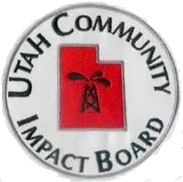Regional Capital Improvements Planning
for Utah Permanent
Community Impact Fund Board (CIB) Applications

WHAT IS THE UTAH PERMANENT COMMUNITY IMPACT FUND BOARD?
 It is a very important source of funding frequently utilized by
eligible entities in Utah to implement capital improvements projects.
The funding comes through what is known officially as the "Utah Permanent Community Impact Fund Board"
but is more commonly referred to as the "CIB". Projects, in order to be eligible
to apply for funding, must be on
the current, county-level-prioritized, Community Impact Board Application
List (please see the one-year list below). An exception to
this requirement to be on the Application List is if there is an unforeseen
project becomes necessary because of a bonafide emergency, or other compelling
reason, with such determination to be made by the Community Impact Board.
It is a very important source of funding frequently utilized by
eligible entities in Utah to implement capital improvements projects.
The funding comes through what is known officially as the "Utah Permanent Community Impact Fund Board"
but is more commonly referred to as the "CIB". Projects, in order to be eligible
to apply for funding, must be on
the current, county-level-prioritized, Community Impact Board Application
List (please see the one-year list below). An exception to
this requirement to be on the Application List is if there is an unforeseen
project becomes necessary because of a bonafide emergency, or other compelling
reason, with such determination to be made by the Community Impact Board.
The Utah Permanent Community Impact Fund Board
provides loans and/or grants to state agencies and subdivisions of the
state which have or may be socially or economically impacted by mineral
resource development on federal lands. Under the Federal Mineral
Lease Act of 1920, lease holders on public land make royalty payments to
the federal government for the development and production of non-metalliferous
minerals.
In Utah, the primary source of these royalties is the commercial production of fossil fuels on federal land held by the U.S. Forest Service and the Bureau of Land Management. Since the enactment of the Mineral Lease Act of 1920, a portion of these royalty payments, called mineral lease payments, has been returned to the state in an effort to help mitigate the local impact of energy and mineral developments on federal lands. The state of Utah then allocates 32.5% of the royalties as Permanent Community Impact Funds. The PCIFB will only fund those applications which are submitted by an eligible applicant for an eligible project.
In Utah, the primary source of these royalties is the commercial production of fossil fuels on federal land held by the U.S. Forest Service and the Bureau of Land Management. Since the enactment of the Mineral Lease Act of 1920, a portion of these royalty payments, called mineral lease payments, has been returned to the state in an effort to help mitigate the local impact of energy and mineral developments on federal lands. The state of Utah then allocates 32.5% of the royalties as Permanent Community Impact Funds. The PCIFB will only fund those applications which are submitted by an eligible applicant for an eligible project.
The Utah statute creating the Board specifically
defines eligible applicants as any of the following: counties, special
service districts, cities, special improvement districts, towns, water
conservancy districts, water or sewer improvement districts, building
authorities, housing authorities, and in certain narrow circumsances,
school districts.
WHAT IS THE REVENUE THE BOARD RECEIVES TO ALLOCATE, AND WHAT TYPES OF PROJECTS DO THEY FUND?
Please click on this LINK to download a PDF file of the most current Legislative Report of the Permanent Community Impact Fund Board which provides information on the revenue received and the projects recently funded by the PCIFB.
WHAT IS THE REVENUE THE BOARD RECEIVES TO ALLOCATE, AND WHAT TYPES OF PROJECTS DO THEY FUND?
Please click on this LINK to download a PDF file of the most current Legislative Report of the Permanent Community Impact Fund Board which provides information on the revenue received and the projects recently funded by the PCIFB.
Below is a table outlining upcoming trimester funding cycle and applicable filing deadlines for the CIB:
HOW DO YOU FIND THE STATE OF UTAH'S CIB WEB SITE?
|
STATE OF UTAH CIB WEBSITE LINK: Please click on THIS LINK to visit the
State of Utah Permanent Community Impact Fund Board (CIB) website.
On that site you will find complete information as well as download links for the most current CIB application form(s). Agendas
for the meetings of the CIB Board are also posted on that site. The CIB
Board meetings are "usually" held on the 1st Thursday of each month, but
the date may vary from time to time, as necessary.
The location of the monthly CIB Board meetings varies throughout the state. The State of Utah CIB site will tell you where the next meeting will be held. Be sure to bookmark the Five County AOG web page so you can return later, as you will be leaving this web site to visit the state's CIB web site. |
IMPORTANT! REMEMBER THAT UNLESS YOU HAVE A BONAFIDE EMERGENCY, OR A COMPELLING REASON TO REQUEST TO BE HEARD BY THE CIB BOARD, ANY PROJECT BEING APPLIED FOR MUST ALREADY BE ON A 1-YEAR CIB APPLICATION LIST.
1-YEAR CIB APPLICATION LISTS FOR USE IN THE
CIB FY2026 FUNDING TRIMESTERS:
Please contact Mr. Cody Christensen (see below) for more information on the Application Lists.
HOW DO I GET TECHNICAL ASSISTANCE WITH PCIFB APPLICATIONS?:
Staff of the Five County Association of Governments provides technical assistance to local communities,counties, special service districts and others in this region to prepare a Capital Asset Self-Inventory (CASI) database and from that self assessment develop a Capital Improvements progrohgam for the entity for development projects proposed in the short-term and longer time periods. These include "brick and mortar" projects as well as other large capital expenditures. From the CASI and Capital Improvements Planning process specirfic actionable Community Impact Board applications for funding are identified. Those are the projects shown on the lists above. Services are available by the Five County staff to assist you in filling out and completing the CIB application form itself when applying for CIB funding.
If you desire more information on the CIB Board required CASI database, Capital Improvement Planning or the PCIFB program in general, or wish to discuss the assistance available from the Association as you prepare an application and ultimately present your application in front of the Community Impact Fund Board members, please contact Mr. Cody Christensen at the Five County Association of Governments at (435) 673-3548 extension 165, or e-mail: cchristensen@fivecounty.utah.gov

Cody Christensen
CIB Regional Planning Project Planner
Five County Association of Governments

